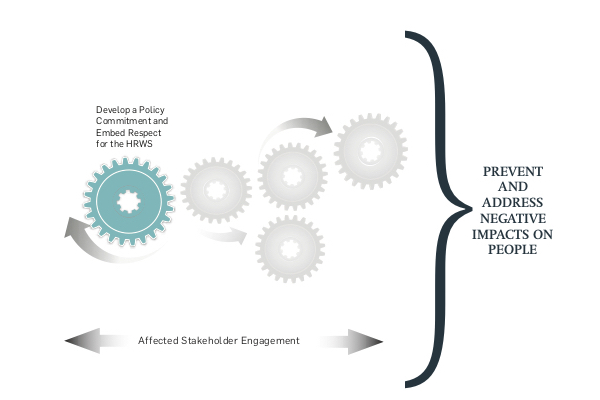
- For a large-scale water-using company, impacts on the HRWS are likely to be a leading human rights risk. The company should consider developing a policy commitment that specifically addresses the HRWS. For other companies, a broader commitment to respect human rights may be sufficient.
- A commitment to respect the HRWS may be stand-alone or integrated into existing human rights, water stewardship, or other corporate commitments.
- A policy commitment should be approved at the highest levels of the company and communicated internally and externally. It should be tested during development with internal colleagues and with affected stakeholders or their representatives.
- To ensure that a commitment is “embedded” throughout its operations, a company needs to drive it into all aspects of the business, including the corporate culture. This will often require cross-functional cooperation among those with responsibility for human rights and for water stewardship.
A company’s policy commitment should, at a minimum, reflect its responsibility to respect the HRWS throughout its operations, including both its own activities and its business relationships. The commitment should set out for staff, business partners, and others in its value chain the company’s expectations about preventing and addressing impacts on the HRWS.
A company should involve relevant staff from across the business in developing or reviewing a policy commitment on the HRWS. Doing so can help build understanding and ownership of the commitment, and increase the likelihood of effective implementation.
Testing a policy commitment with key stakeholder groups can help a company understand how the policy is likely to be seen by those groups. Wherever possible, this should include potentially affected stakeholders or their legitimate representatives.
Once a company has adopted a policy commitment, it should communicate it both internally and externally.
Appropriate internal accountability structures should be established to ensure that the commitment is acted upon, particularly when important business decisions are being made.
Larger companies should pay particular attention to coordination among relevant functions in order to successfully embed a policy commitment on the HRWS. Unless those with responsibility for the specific activities or business relationships that may give rise to human rights impacts are involved in implementing the commitment, effective action to prevent and address specific impacts may be limited.
To successfully embed respect for the HRWS in the daily activities of staff, the expectations in a policy commitment should be reflected in performance incentives, tailored guidance, and training.
A company should set clear expectations about respecting the HRWS from the start of its business relationships, in order to lay the foundation for effective action to prevent and address impacts throughout the relationship.
| What are leading human rights risks? |
| Leading human rights risks are the ones that stand out for a company as being most at risk from the company’s operations (including its own activities and business relationships), when considered from the perspective of potentially affected stakeholders. The UN Guiding Principles make clear that companies should not ignore other human rights risks, but they will logically focus their primary attention on leading risks, especially where resources are limited. |
| What are internationally recognized human rights? |
| The UN Guiding Principles define these rights as, at a minimum, including those contained in the: – Universal Declaration on Human Rights – International Covenant on Civil and Political Rights and the International Covenant on Economic, Social and Cultural Rights – International Labour Organisation’s Declaration on Fundamental Principles and Rights at Work. Where businesses may affect potentially vulnerable or marginalized groups, they should also pay attention to the special human rights standards applying to those groups. |
| Who is an impact owner? |
| Impact owners are individuals within the company with responsibility for those activities (e.g., human resources, community relations, operations) or business relationships (e.g., purchasing and supply chain management) that may lead to negative impacts. Other functions that may be important to engage in any effort related to respecting human rights include legal and compliance. |
| What is a business relationship? |
| These are relationships a company has with business partners, entities in its value chain, and any other entity (state or nonstate) directly linked to its operations, products, or services. They include indirect business relationships in the value chain, beyond the first tier, and minority and majority shareholding positions in joint ventures. |

